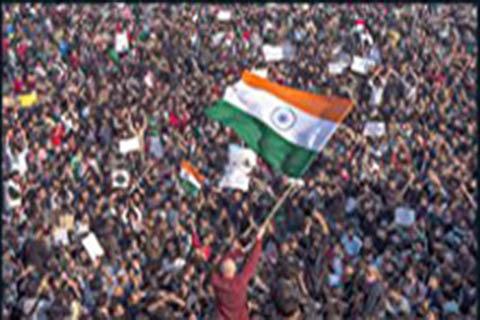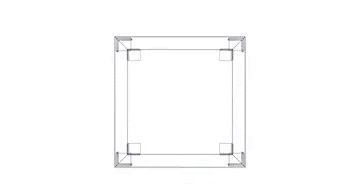A ‘Muslim Bogey’ to Unite Hindus

Commenting on Hindutva’s ambitious project to “unite all Hindus”, Aakar Patel, former editor and current Executive Director of Amnesty International, offers an interesting argument. While it shouldn’t take much effort and imagination to unify an 85 per cent strong majority, Hindus are not a monolithic community. Far from it. While Hindutva insists on bringing everyone under the overarching canopy of Hinduism, communities like the Sikhs, Jains and now even Lingayats bristle at being branded as Hindus.
Much like Buddhism, Jainism and Sikhism came into existence as reform movements against unjust social practices sanctioned by Hindu clergy. Buddha preached against idol worship and exploitation by the priestly class. Buddhism, which is today one of the world’s largest religions, paid a huge price for taking on the clergy and suggesting you do not need middlemen to find salvation. It got wiped out from the land of its birth.
Sikhism, originating as a protest against discrimination practiced in the name of ‘Varna’ or caste, had been inspired by Islam’s egalitarian teachings. Even among the myriad castes, which see themselves as Hindus, there are so many divisions and sects. They do not go to the same temples and pray to same deities, let alone marry into each other’s communities.
For all the progress that India has made since Independence, upper castes like Brahmins and Rajputs still rule the roost and would not marry in ‘inferior’ castes like Yadavs, Kurmis or Kaistha, let alone give their daughters in marriage to Dalits. Forget about marrying into higher castes, the Dalits in many parts of the country cannot even pray in the same temples.
Some years ago, a Bihar temple had to undergo elaborate ‘purification’ after the then Dalit Chief Minister Jitan Ram Manjhi prayed there! The caste remains the biggest reality in the 21st century India. These strict schisms and ruptures persist even in the more progressive and educated South India.
As Dr BR Ambedkar, the brilliant Dalit author of Indian Constitution and a strong critic of untouchability, wrote: “Caste is not a physical object like a wall of bricks or a line of barbed wire which prevents the Hindus from co-mingling and which has, therefore, to be pulled down. Caste is a notion; it is a state of the mind.”
Commenting on the attempts to unite all Hindus under a common flag, he wrote: “By its very genius Hinduism believes in social separation, which is another name for social disunity and even creates social separation. If Hindus wish to be one, they will have to discard Hinduism. Hinduism is the greatest obstacle to Hindu unity.” Given these edifying observations of Ambedkar, how do you make sense of Hindutva’s breathless rush to embrace the Dalit icon, absurdly suggesting he somehow shared its extremist worldview?
But the Parivar needs Ambedkar and his legacy to court the Dalits and perpetuate the myth of Hindu unity. While Ambedkar despised Hinduism and converted to Buddhism with thousands of his followers, the BJP has been undertaking an elaborate charade to portray itself as his ardent follower and champion of the long oppressed Dalits. This even as attacks against the Dalits have acquired a frightening pattern under the current order.
Doubtless, the Dalits have witnessed unprecedented transformation in their lives since Independence thanks to reservations or affirmative action. Which they deserve after thousands of years of dehumanizing discrimination and oppression at the hands of the upper caste elites. Yet this empowerment has not put an end to atrocities against the community, especially in the deeply stratified Hindu society in the North. Dalit women are still raped and their men are shown their place in numerous ways on a daily basis.
Yet the Dalits, as are the other backward communities and groups, are a critical and integral part of the great Hindutva project to present the façade of a harmonious Hindu society belying the grievous divisions and contradictions within this ideal, happy family.
This is why the specter of ‘Muslim threat’ to the Hindu society has to be kept alive at any cost. It is important to come up with newfangled myths and fictions about the Muslims preying on fair Hindu maidens and their multiplying numbers threatening the majority. Ironic as it may sound, Hindutva believes that only the Muslim bogey can unite all Hindus delivering it a solid vote bank. Besides, polarization always helps wins elections. Who would know it better than the BJP or Modi, having effortlessly leaped from Gujarat to Delhi?
Interestingly, unnerved by the rising Dalit anger, Modi has asked BJP MPs to spend at least two days, around the time of Ambedkar’s birth anniversary (April 14) in the Dalit-dominated villages and towns to reassure the community that the BJP has its best interests at heart.
The Dalits, including many BJP MPs, have lately been up in the arms over the recent Supreme Court ruling diluting the SC-ST Prevention of Atrocities Act that protected the community against discrimination. The Dalits see the SC move as yet another sign of upper caste tyranny and creeping Hinduization of the state.
Now, Hindutva genuinely wants to unify all Hindus but this inclusion happens on its own terms, as Aakar Patel reasons. For example, ‘Hindu’ in its lexicon means someone who is ideally vegetarian and certainly non-beef eating.
“Prime Minister (Modi) comes from a meat-eating community of Gujaratis but he has chosen to give up that culture and become more RSS-like. This has made him acceptable. Had he been a beef-eating Adivasi, it would not have been easy for the RSS to make him the chief minister of Gujarat,” he notes.
The other impediment in the path of Hindu unity, suggests the former journalist who has long followed Modi and Hindutva, is that Hindu upper castes are a natural constituency for the BJP, and this core constituency is fundamentally opposed to Dalit rights though they might not say it openly. “Does the upper caste support reservations? The answer is no, because reservations to Dalits and Adivasis come at the expense of this group. This is a division that is so fundamental that it cannot be papered over in the name of Hindu unity. In such a situation, “sabka saath” is not possible.”
